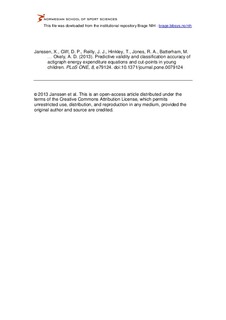| dc.contributor.author | Janssen, Xanne | |
| dc.contributor.author | Cliff, Dylan | |
| dc.contributor.author | Reilly, John J. | |
| dc.contributor.author | Hinkley, Trina | |
| dc.contributor.author | Jones, Rachel A. | |
| dc.contributor.author | Batterham, Marijka | |
| dc.contributor.author | Ekelund, Ulf | |
| dc.contributor.author | Brage, Søren | |
| dc.contributor.author | Okely, Anthony D. | |
| dc.date.accessioned | 2014-03-14T09:59:30Z | |
| dc.date.available | 2014-03-14T09:59:30Z | |
| dc.date.issued | 2013-11-11 | |
| dc.identifier.citation | PLoS ONE. 2013, 8, e79124 | nb_NO |
| dc.identifier.uri | http://hdl.handle.net/11250/191612 | |
| dc.description | © 2013 Janssen et al. | nb_NO |
| dc.description.abstract | Objectives: Evaluate the predictive validity of ActiGraph energy expenditure equations and the classification accuracy of physical activity intensity cut-points in preschoolers.
Methods: Forty children aged 4–6 years (5.3±1.0 years) completed a ~150-min room calorimeter protocol involving age-appropriate sedentary, light and moderate-to vigorous-intensity physical activities. Children wore an ActiGraph GT3X on the right mid-axillary line of the hip. Energy expenditure measured by room calorimetry and physical activity intensity classified using direct observation were the criterion methods. Energy expenditure was predicted using Pate and Puyau equations. Physical activity intensity was classified using Evenson, Sirard, Van Cauwenberghe, Pate, Puyau, and Reilly, ActiGraph cut-points.
Results: The Pate equation significantly overestimated VO2 during sedentary behaviors, light physical activities and total VO2 (P<0.001). No difference was found between measured and predicted VO2 during moderate-to vigorous-intensity physical activities (P = 0.072). The Puyau equation significantly underestimated activity energy expenditure during moderate-to vigorous-intensity physical activities, light-intensity physical activities and total activity energy expenditure (P<0.0125). However, no overestimation of activity energy expenditure during sedentary behavior was found. The Evenson cut-point demonstrated significantly higher accuracy for classifying sedentary behaviors and light-intensity physical activities than others. Classification accuracy for moderate-to vigorous-intensity physical activities was significantly higher for Pate than others.
Conclusion: Available ActiGraph equations do not provide accurate estimates of energy expenditure across physical activity intensities in preschoolers. Cut-points of ≤25counts⋅15 s−1 and ≥420 counts⋅15 s−1 for classifying sedentary behaviors and moderate-to vigorous-intensity physical activities, respectively, are recommended. | nb_NO |
| dc.language.iso | eng | nb_NO |
| dc.publisher | PLOS.org | nb_NO |
| dc.subject | VDP::Matematikk og Naturvitenskap: 400::Basale biofag: 470 | nb_NO |
| dc.subject | VDP::Landbruks- og Fiskerifag: 900::Landbruksfag: 910 | nb_NO |
| dc.subject | accelerometers | nb_NO |
| dc.subject | basal metabolic rate measurement | nb_NO |
| dc.subject | bioenergetics | nb_NO |
| dc.subject | calorimetry | nb_NO |
| dc.subject | children | nb_NO |
| dc.subject | games | nb_NO |
| dc.subject | hip | nb_NO |
| dc.subject | jumping | nb_NO |
| dc.title | Predictive validity and classification accuracy of actigraph energy expenditure equations and cut-points in young children | nb_NO |
| dc.type | Journal article | nb_NO |
| dc.type | Peer reviewed | nb_NO |
| dc.source.journal | PLoS ONE | nb_NO |
| dc.identifier.doi | 10.1371/journal.pone.0079124 | |
| dc.description.localcode | Seksjon for idrettsmedisinske fag / Department of Sport Sciences | nb_NO |
